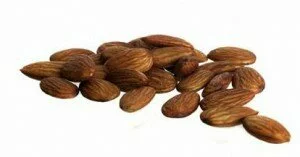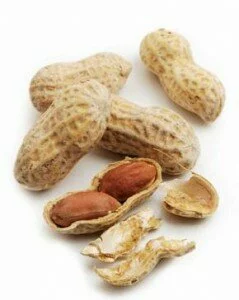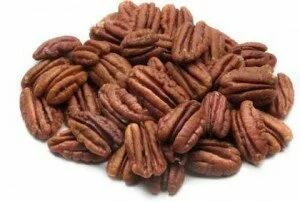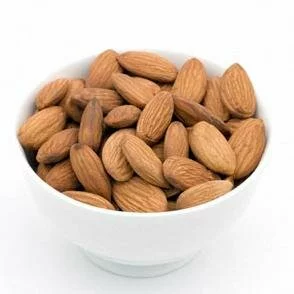All about nuts, edible kernels and hard shell
Cooks and grocers define nuts as anything with edible kernels and hard shells. This includes true nuts like chestnuts and acorns, but also things that botanists would class as seeds, like Brazil nuts, or legumes, like peanuts. Nuts are usually high in fat and protein, and people throughout the world eat them as snacks or incorporate them into both sweet and savory dishes. Many nuts can be eaten raw but roasting them helps intensify their flavor. Nuts are usually harvested in the fall, and it’s best to buy unprocessed nuts then. Many unshelled nuts can be kept for up to a year in a cool place, but shelled nuts, especially those that have been cut or roasted, are more prone to rancidity and should be stored in the refrigerator or freezer in an airtight container. Substitutes: Grape-nuts cereal OR dried fruit OR granola OR rolled oats (toast them first) OR chocolate chips (in sweet dishes)
almond = sweet almond Equivalents: 3 ounces whole almonds = 1/2 cup = 65 almonds Notes: Almonds have a crunchy texture and a rich, delicate flavor that’s especially good in desserts, like candy, ice cream, tortes, and coffee cake. To intensify their flavor, toast them on a baking pan in a 325° degree oven, stirring occasionally, until they’re golden (about 15 minutes for whole almonds). You can buy almonds shelled or unshelled, blanched, sliced, slivered, ground, or chopped. Substitutes: hazelnuts (for baking) OR Brazil nuts OR cashews OR pistachios (unsalted)
beechnut = beechmast = beech nut Notes: Beechnuts are small, triangular nuts. They’re usually roasted. Substitutes: hazelnuts
bitter almond Notes: Unprocessed bitter almonds have a more intense flavor than ordinary almonds, but they aren’t available in the United States since they’re mildly toxic if eaten raw. Instead, they’re processed and used to make oil of bitter almonds, almond extract, almond liqueurs, and orgeat syrup. This name is often used (incorrectly) for the chinese almond. Substitutes: Chinese almonds (Warning: Cook these before eating to remove toxins.) OR oil of bitter almonds (1 drop = 6 bitter almonds) OR almonds plus a few drops of almond extract OR almonds plus some amaretto liqueur (not as flavorful, more oily)
 blanched almond Notes: Shelled almonds have a slightly bitter brown skin which can be removed by blanching them. To do this, drop shelled almonds into boiling water, remove the pan from the heat source and let it stand for two minutes, then drain the almonds and rub off the skins. Many cooks prefer to skip this step and buy their almonds already blanched.
blanched almond Notes: Shelled almonds have a slightly bitter brown skin which can be removed by blanching them. To do this, drop shelled almonds into boiling water, remove the pan from the heat source and let it stand for two minutes, then drain the almonds and rub off the skins. Many cooks prefer to skip this step and buy their almonds already blanched.
Brazil nut = para nut = cream nut Equivalents: 2 pounds unshelled = 1 pound shelled Notes: These nuts come from the Amazonian rainforest, and they’re rich in protein, omega-3 fatty acid, and calcium. They’re prone to rancidity, so store them in the refrigerator or freezer if you plan to keep them for awhile. It’s easier to shell them if you first heat them in a 350° oven for about 15 minutes. Substitutes: macadamia nuts (use 3 times as many) OR paradise nut OR almonds OR pecans
cashew Pronunciation: KA-shoe Notes: These rich, sweet nuts have a toxic shell, so they’re almost always sold shelled. Toast them briefly in the oven to boost their flavor. Substitutes: peanuts (in stir-fry dishes or for making nut butter) OR pine nuts OR almonds OR pecans OR water chestnuts (in stir-fry dishes)
chestnut = marron Equivalents: One pound in the shell = 2 1/2 cups shelled whole nuts Notes: These sweet, starchy, low-fat nuts are quite common in southern Europe, where people eat them hot from the roaster, or add them to soups, stuffing, and desserts. They appear fresh in the fall and winter, but you can find them dried, vacuum-packed, or canned throughout the year. Before you can eat them, fresh chestnuts need to be boiled or roasted, and then shelled and peeled. To roast them, cut an X into each shell (to allow steam to escape) and bake them in a 400° oven for about twenty minutes. While they’re still warm, peel off both the shell and the furry skin surrounding each nut. Alternatively, boil the chestnuts for about 15 minutes, then remove them from the water with a slotted spoon. Peel off the shells and put the nuts back in the boiling water for another minute, then remove them again and peel off the skins. Select fresh chestnuts that are shiny and heavy for their size. Store them in the refrigerator and use them within a week or so. Don’t confuse chestnuts with water chestnuts, which are completely different. Substitutes: breadnuts OR jackfruit seeds OR chufa nuts OR hazelnuts (for stuffing poultry) OR pecans (for stuffing poultry)
 Chinese almond = apricot seed = hang yen = dried almond Notes: These aren’t really almonds at all, but apricot kernels. They taste a lot like bitter almonds, and have a rich, heavenly almond-extract fragrance. They’re mildly toxic if eaten raw, so they should always be roasted or blanched before using. Look for plastic bags of them in Chinese markets. Substitutes: bitter almonds (These are also mildly toxic if eaten raw, so they aren’t available in the United States.) OR oil of bitter almonds (just a few drops) OR almonds plus a few drops of almond extract OR almonds (not as flavorful, more oily)
Chinese almond = apricot seed = hang yen = dried almond Notes: These aren’t really almonds at all, but apricot kernels. They taste a lot like bitter almonds, and have a rich, heavenly almond-extract fragrance. They’re mildly toxic if eaten raw, so they should always be roasted or blanched before using. Look for plastic bags of them in Chinese markets. Substitutes: bitter almonds (These are also mildly toxic if eaten raw, so they aren’t available in the United States.) OR oil of bitter almonds (just a few drops) OR almonds plus a few drops of almond extract OR almonds (not as flavorful, more oily)
dried chestnut Notes: You reconstitute these by boiling them for about an hour. They’re available in Italian markets, but you’ll usually pay less if you get them in an Asian market.
hazelnut = filbert = cobnut Notes: Hazelnuts have a crunchy texture and an appealing flavor that goes especially well with chocolate. Unshelled nuts show up in the produce department of larger supermarkets in the fall and winter. Shelled nuts are available year-round near the baking supplies. Before you use them, toast shelled hazelnuts in a 325° oven for ten to fifteen minutes, stirring occasionally. As soon a you take them from the oven, rub the nuts vigorously with a towel to remove their bitter brown skins. Substitutes: beechnuts OR almonds OR walnuts OR pecans OR Brazil nuts OR macadamia nuts
hickory nut Notes: These are delicious, but they aren’t grown commercially because the shells are so hard. Pecans are a very close relative. Substitutes: pecans (very similar and much easier to shell)
macadamia nut = Queensland nut = Australian nut Pronunciation: mack-uh-DAY-me-uh Notes: These rich and creamy nuts hail from Hawaii and Australia, where they’re eaten as snacks, or incorporated into cookies or other desserts. They’re hard to crack open and tricky to roast, so they’re almost always sold shelled and roasted in vacuum-pack containers. After you open these containers, you should store any uneaten nuts in the freezer or refrigerator, since they’re high in fat and therefore prone to rancidity. If you want to roast your own macadamia nuts, put them in 275° oven for about 15 minutes. Substitutes: Brazil nut (stronger flavor, 3 times as large) OR pecans OR walnuts OR almonds OR cashews
peanut = groundnut = monkey nut = goober = goober pea Notes: These aren’t really nuts, but legumes that grow underground. They’re cheaper than most nuts, and are often eaten out of hand or incorporated into candies, stir-fries, or trail mixes. You can buy them shelled or unshelled, salted or unsalted, raw or roasted. To roast, place shelled peanuts on a cookie sheet in a 350° oven for about 15 to 20 minutes. Since many people are allergic to peanuts, it’s important to alert guests if you’re serving something that’s made with peanuts or peanut products. Substitutes: cashews (for stir-frying or for making nut butter) OR almonds (for making nut butter)
 pecan Pronunciation: pih-CAHN OR pih-CAN Equivalents: 1 pound in the shell = 1/2 pound shelled = 2 cups shelled Notes: This North American nut is like a walnut, only sweeter and milder. It’s used widely in the South to make pralines, pecan pie, ice cream, and nut breads. They’re high in fat, so it’s best to store shelled pecans in the refrigerator or freezer to prevent them from turning rancid. To roast, put shelled pecans on a baking pan and in bake them in a 325° oven, stirring occasionally, until they’re slightly golden, about ten minutes. Substitutes: walnuts OR hickory nuts (similar, but harder to shell)
pecan Pronunciation: pih-CAHN OR pih-CAN Equivalents: 1 pound in the shell = 1/2 pound shelled = 2 cups shelled Notes: This North American nut is like a walnut, only sweeter and milder. It’s used widely in the South to make pralines, pecan pie, ice cream, and nut breads. They’re high in fat, so it’s best to store shelled pecans in the refrigerator or freezer to prevent them from turning rancid. To roast, put shelled pecans on a baking pan and in bake them in a 325° oven, stirring occasionally, until they’re slightly golden, about ten minutes. Substitutes: walnuts OR hickory nuts (similar, but harder to shell)
pine nut = pinoli = pinyon = pinolea = pignolia = Indian nut = piñon = pignolo = pignoli = snoober = pine kernel Notes: These expensive and delicate seeds are harvested from pine trees in different parts of the world. Italians like to grind them into pesto or sprinkle them on pasta dishes. There are two main varieties: the triangular Chinese pine nuts sold in Asian markets, and the slender Italian pine nuts, which are more expensive and subtly flavored. All pine nuts are high in fat, so store them in the refrigerator or freezer to keep them from getting rancid. Before you use them, toast pine nuts in a 325° oven, stirring occasionally, until they’re slightly golden, about five minutes. Substitutes: walnuts (this is a common variation in pesto) OR almonds (this is a common variation in pesto) OR hazelnuts (this also works in pesto) OR cashews (raw, unsalted) OR peanuts (unsalted) OR sunflower seeds
pistachio nut Pronunciation: pih-STASH-ee-yoh Equivalents: 2 cups pistachios in the shell = 1 cup shelled nutmeats Notes: These green Middle Eastern nuts are encased in tan shells, which are sometimes dyed red. They’re crunchy and delicately sweet, so they’re great in everything from ice cream to pilafs. When the nuts are mature enough to eat, the shells split open enough that they can be pulled off easily with your fingers. Unopened shells contain immature kernels and should be discarded. Pistachios are available shelled or unshelled, salted or unsalted, roasted or raw. To roast, put shelled pistachios on a baking pan and in bake them in a 325° oven, stirring occasionally, until they’re slightly golden, about ten minutes. Substitutes: pine nuts OR blanched almonds
sliced almonds Equivalents: 3 ounces = 1 cup Notes: You can buy almonds already sliced, or do it yourself using a food processor fitted with a slicing disk. It’s best to toast the sliced almonds before using them. Just spread them on a baking sheet and put them in a 350° oven until they’re light brown, about five to ten minutes.
slivered almond Equivalents: 3 ounces = 2/3 cup Notes: You can buy slivered almonds in the baking supplies section of most supermarkets. To sliver a blanched almond yourself, use a paring knife to cut it lengthwise into several small sticks.
walnut Equivalents: 1 cup chopped = 4 1/2 ounces; 1 cup halves = 3 1/2 ounces; 1 pound unshelled yields 1 1/2 cups shelled Notes: Walnuts are rich and flavorful, and cooks like to use them in everything from fudge to salads. Markets usually carry English walnuts = royal walnuts = Persian walnuts. Less common are black walnuts, which are much more flavorful but harder to shell. To roast, put shelled walnuts on a baking pan and in bake them in a 325° oven, stirring occasionally, until they’re slightly golden, about ten minutes. After you remove the nuts from the oven, rub them vigorously with a towel so as to remove as much of their bitter skins as possible. Fresh walnuts are available year-round, but they’re best in the fall. Since they’re high in fat and therefore prone to rancidity, it’s best to store them in the refrigerator or freezer. Substitutes: butternuts OR pecans (not as crunchy or flavorful) OR hazelnuts (not as rich) OR pine nuts (especially in pesto)
![]() Share on Facebook
Share on Facebook
Incoming search terms:
- edible kernels








